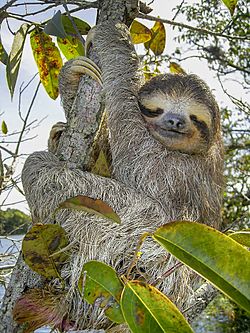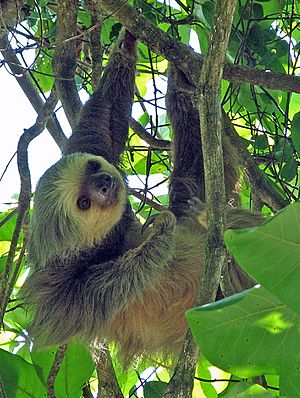Sloth facts for kids
Quick facts for kids Sloths |
|
|---|---|
 |
|
| Brown-throated three-toed sloth (Bradypus variegatus). | |
| Scientific classification | |
| Kingdom: | |
| Phylum: | |
| Class: | |
| Superorder: | |
| Order: | |
| Suborder: |
Folivora
|
Sloths are slow-moving mammals that live in Central and South America. They belong to a group of animals called Xenarthra. There are two main types of sloths: two-toed sloths and three-toed sloths. Most scientists call these two groups the Folivora.
Sloths have been living in South America for a very long time, about 60 million years. Later, they also moved into Central America.
Contents
Physical Description
Most sloths are about the size of a small dog. They have short, flat heads. Their fur is usually grayish-brown. Sometimes, they look grey-green because tiny algae (like tiny plants) grow on their fur. This helps them blend in with the trees. Sloths have strong, hook-like claws on their arms and legs. These claws help them hold onto trees very tightly.
Life
Sloths are usually active at night. During the day, they sleep curled up. They might put their head between their arms or hang upside down. Their hook-like claws help them stay attached to branches. This sleeping position helps them look like part of a tree. This way, enemies like the jaguar might not see them.
Sloths rarely come down from trees. When they are on the ground, they move very slowly and awkwardly. But if there's a flood in the forest, sloths are actually very good swimmers!
Diet

Baby sloths learn what to eat by licking their mother's lips. All sloths eat the leaves of the cecropia tree.
Two-toed sloths eat many different things. Their diet includes insects, dead animals, fruits, leaves, and small lizards. They can travel over a large area to find food. Three-toed sloths, however, eat only leaves from a few types of trees. They digest their food very slowly, slower than any other mammal.
Sloths have special bodies for eating leaves while living in trees. Leaves don't give much energy or nutrients. They are also hard to digest. So, sloths have large stomachs with many parts. Special bacteria in their stomachs help break down the tough leaves. Up to two-thirds of a sloth's body weight can be the food in its stomach! It can take a month or more for a sloth to digest one meal.
About once a week, three-toed sloths go down to the ground. They dig a hole to go to the bathroom and then cover it up. They usually go to the same spot every time. When they are on the ground, they are in danger from predators. This behavior might help the tiny living things in the sloth's fur.
Reproduction
Most sloths have one baby at a time. Three-toed sloths are pregnant for about six months. Two-toed sloths are pregnant for about 12 months. Newborn sloths stay with their mother for about five months. Sometimes, a baby sloth might fall from a tree. The mother might not leave the safety of the tree to get her baby.
Female sloths usually have one baby each year. But because sloths move so slowly, sometimes females can't find a male for more than a year. It's hard to tell male and female sloths apart just by looking at them.
Scientists don't know the exact lifespan of two-toed sloths in the wild. In zoos, they can live for about 16 years. One sloth at the Smithsonian National Zoo lived to be 49 years old!
Distribution
Sloths live only in the tropical rainforests of South and Central America. In these areas, they are very common. For example, on Barro Colorado Island in Panama, sloths make up 70% of the weight of all tree-living mammals.
Four of the six types of sloths are currently not in danger. The maned three-toed sloth lives in Brazil's shrinking Atlantic Forest and is considered "vulnerable." The pygmy three-toed sloth, which lives only on an island, is "critically endangered." Sloths have a low metabolism, which means their bodies use energy slowly. This is why they can only live in warm, tropical places. They sometimes warm themselves in the sun, like cold-blooded animals.
Related pages
Images for kids
-
Megatherium americanum (Megatheriidae, London)
-
Nothrotheriops shastensis (Nothrotheriidae, La Brea)
-
Paramylodon harlani (Mylodontidae, San Diego)
-
Feeding brown-throated three-toed sloth (Bradypus variegatus), Cahuita National Park, Costa Rica
See also
 In Spanish: Folivora para niños
In Spanish: Folivora para niños







